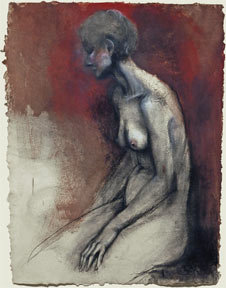Jim Dine
dal 9/2/2007 al 11/3/2007
Segnalato da
9/2/2007
Jim Dine
Leslie Sacks Fine Art, Los Angeles
Over four decades, the artist has produced more than thirty-five hundred paintings, sculptures, drawings, and prints, as well as performance works, stage and book designs. Dine is best known for his repetitive iconography, e.g., robes, hearts, tools and the Venus De Milo.

Solo show
This exhibition of works by Jim Dine at Leslie Sacks Fine Art is being presented to coincide with the Pepperdine University show, Jim Dine: Some Drawings, running from January 6 through March 25 at the Frederick R. Weisman Museum of Art.
Over four decades, Jim Dine has produced more than thirty-five hundred paintings, sculptures, drawings, and prints, as well as performance works, stage and book designs. Dine is best known for his repetitive iconography, e.g., robes, hearts, tools and the Venus De Milo. These themes will be well represented in the Dine show at Leslie Sacks. Also featured in this show is a superb, large scale drawing of a female figure, A Reddish Nude, rendered in a manner both expressionist and classical.
Dine is, indeed, essentially an expressionist with a classical bent. His style emphasizes draftsmanship yet underscores the ultimate importance of emotional content. His concern with drawing can be seen in attention to the dramatic yet delicate development of light and shadow in modeling Reddish Nude. Some areas of the drawing have been rendered and then heavily erased, breaking through the surface of the paper and revealing the white, inner pulp as though seeking to reveal the innermost content of the image.
The prints in the Sacks show will include two large robes, Pale Self and Very Picante, and an equally imposing Venus, Oil of Gladness. The Venus De Milo and the robe are, like the heart, recurring iconographic themes for Dine. The Venus image came into his vocabulary through the presence of a plaster of Paris reproduction in his studio. As in its original, classical incarnation, the Venus is Dine’s muse: a symbol of fertility, i.e., archetypal maternal figure, and the embodiment of the romantic ideal. Dine’s Venus is the counterpart of his robes, which are clearly male icons, as communicated by both the implied stance (hands on hips and arms akimbo) and the proportions of the garment.
The robes are always absent a body within them. In Marco Livingstone’s monograph, Jim Dine: The Alchemy of Images, both Livingstone and Dine comment extensively on this symbolism. There is nothing simplistic about it, but to summarize it may be said that it proceeds from his conscious efforts to realize an identity, both personal and existential. Installed next to Pale Self is a nearly identical robe, Very Picante. Printed from the same plate, this companion piece, as implied by its title, has a hot palette, particularly in comparison to the pastel colors of Pale Self. Though from the same plates, these two works produce radically different feelings. Both are equally brilliant examples of the use of color as a compositional element.
The hand colored lithographs of carpentry tools from Ten Winter Tools speak of the workman like way Dine goes about making images. This humility gives weight and authenticity to Dine’s art. His consistent concern with artistry flies in the face of the purely conceptual works which have long dominated critical attention, while honoring the value of ideas, i.e., intellectual content.
Leslie Sacks Fine Art
11640 San Vicente Blvd. (Brentwood) - Los Angeles



